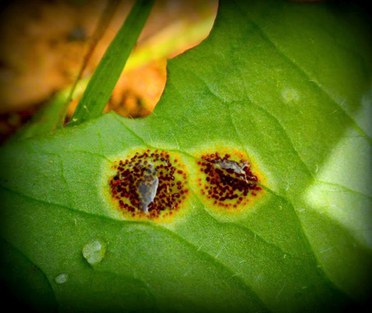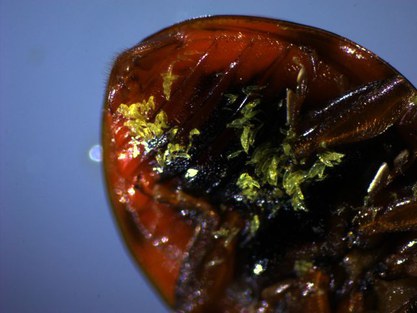International team explores the mysterious and understudied parasitic microfungi
September 2021
The world around you is teeming with life you can’t see. Plants, soil, water, insects — even your hair and skin — are home to microfungi, and they both sustain and devastate life on our planet. Parasitic microfungi, which live off of host plants and animals, maintain balance in natural ecosystems, but in developed areas can quickly destroy crops and financially devastate communities.
A team led by Purdue University mycologist M. Catherine Aime will venture to sites across the globe – including the tropics, where the vast majority of emerging crop diseases originate – to discover and identify thousands of species of parasitic microfungi. The team will focus on two parasitic microfungi groups: Pucciniales, which causes rust disease in plants, and Laboulbeniales, which parasitize arthropods. The project is supported by $1.5 million from the National Science Foundation, and also seeks to help resolve the “Tree of Life” for these groups.
“Microfungi are among the least understood living organisms on the planet, and they can be rule breakers,” said Aime, a professor in the Department of Botany and Plant Pathology. “Rusts don’t follow the typical patterns of evolution. Where we expect to see the genomes of parasites become compacted over time, theirs have expanded and we don’t know why. This study could lead to a fundamental change in the way we understand genome architecture. The implications could extend even to organisms beyond fungi.”
Aime is collaborating with Carl Dick, an associate professor of biology at Western Kentucky University; Danny Haelewaters, a postdoctoral fellow at Ghent University; Alisha Quandt, assistant professor of ecology and evolutionary biology at the University of Colorado Boulder; and Kyryll Savchenko, assistant professor of biological sciences at Butler University. Other collaborators include: Meredith Blackwell professor emeritus of biology at Louisiana State University, Don Pfister, professor emeritus of organismic and evolutionary biology at Harvard University and Giuliana Furci, CEO of the Fungi Foundation in Chile.
Haelewaters is an expert in Laboulbeniales taxonomy and systematics. “While over 2,000 species have been described, we expect many more, up to tens of thousands more. We find undescribed species of Laboulbeniales everywhere we go – in the tropics of course but also in well-sampled areas such as the USA, Belgium, and the Netherlands,” he said.
Parasitic microfungi will be sampled in North Carolina, Panama, Guyana, Patagonia, the Czech Republic, Armenia, Mozambique, and Brunei. The team will also involve the public by organizing community bat nights, in order to collect bat flies from captured bats, and working with citizen scientists in the jungle to describe new species.
Aime and Haelewaters are pioneers in the identification of parasitic microfungi that cannot be put into culture. They will use DNA-sequencing techniques to perform identification previously impossible. “Many microfungi viewed under a microscope are indistinguishable,” Aime said. “For instance, Pucciniales has five different spore stages, each of which looks different within a species, but the same spores stages can look the same between species. DNA sequencing allows us to clearly see distinctions and properly identify separate species and stages of development. We chose two of the least studied - but very consequential - types of microfungi, and we will be providing the first genomic resources for most of the species within them.”
“Likewise, a single Laboulbeniales species may have different morphologies, depending on where on its host it is growing. There is also a growing belief that many of the previously described taxa with many hosts and large distributional areas are in fact complexes of multiple species with no or very few morphological differences. These issues make it impossible to identify based on morphology alone in Laboulbeniales,” according to Haelewaters.
The research will evaluate what geographic regions have the highest diversity of parasitic microfungi and will test the latitudinal gradient hypothesis established for plants and animals. “This hypothesis suggests diversity is negatively linked to increasing latitude,” Aime said. “However, some recent studies suggest the opposite to be true for fungi. We think this may be due to the patchiness of fungal distribution in the tropics, like a quilt where one square doesn’t tell the story of the full, colorful piece. Our standardized sampling in tropical and temperate areas will for the first time allow for a robust comparison.”
“There are more than six times as many species of fungi as plants, but there aren’t very many mycologists at universities,” she said. “It is a new field, relatively speaking, because until the 1970s fungi were classified under the plant kingdom. Now we know fungi is a kingdom itself, and the organisms actually have more in common with animals than plants. There is so much to learn, and we need to scale up mycological education and professional training.”
The project will include undergraduate and graduate level education, community engagement, and the organization of workshops and fieldwork programs. Another important aspect will be the creation of a platform to house and share a rapidly growing microfungi dataset. The team expects to create the most exhaustive documentation of microfungi in these two orders to date. This massive dataset will be a rich and growing resource that can inform fungal systematics, ecological and evolutionary research.
The flip side of disease prevention is the need to understand parasitic microfungi to sustain ecosystems. “In nature, these parasites are critical to ecosystem health,” Aime said. “They play an important role by encouraging diversity in their hosts. They prevent one species from taking over and maintain balance. If we want to preserve or restore habitats, we have to look at the whole system, including what we can’t see. These microbes are as important as the plants and animals.”
NSF grant DEB-2127290, "Collaborative Research: PurSUiT: Species diversity and evolution of parasitic microfungi"

